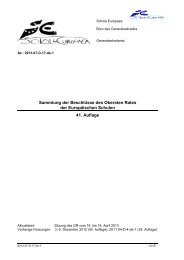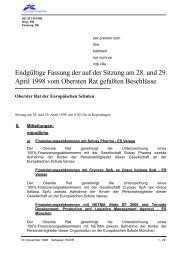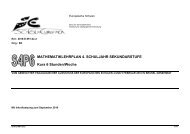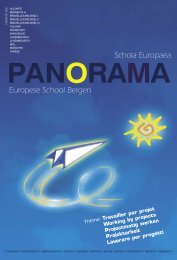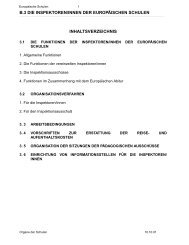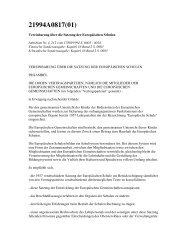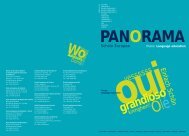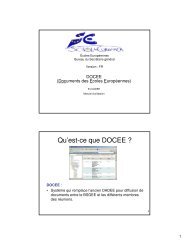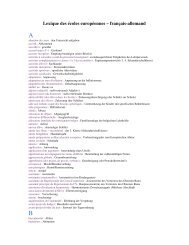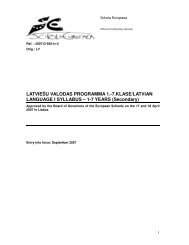External Evaluation of the European Baccalaureate (Annexes)
External Evaluation of the European Baccalaureate (Annexes)
External Evaluation of the European Baccalaureate (Annexes)
You also want an ePaper? Increase the reach of your titles
YUMPU automatically turns print PDFs into web optimized ePapers that Google loves.
out <strong>of</strong> <strong>the</strong> class room. If <strong>the</strong> class teacher marks are altered by <strong>the</strong> external moderator, <strong>the</strong>re is no<br />
feedback to schools as to <strong>the</strong> reasons why. If <strong>the</strong>re is a difference in opinion on <strong>the</strong> marks allocated<br />
against <strong>the</strong> criteria, from a sample selection <strong>of</strong> scripts ( usually one top, one middle, one bottom in terms<br />
<strong>of</strong> marks awarded by <strong>the</strong> teacher) <strong>the</strong> marks for <strong>the</strong> class will be scaled up or down by <strong>the</strong> moderator.<br />
To summarise, <strong>the</strong> written exams take similar formats with short-response questions and extended-<br />
response questions in both exams. Choice is given in <strong>the</strong> EB exam, no choice in <strong>the</strong> IB exams. The IB has<br />
an additional formal exam on <strong>the</strong> optional section studied, <strong>the</strong> EB has summative assessment in year 7<br />
based on class work. The EB can include an oral exam, which accounts for 24 <strong>of</strong> <strong>the</strong> final mark; <strong>the</strong> IB has<br />
extended pieces <strong>of</strong> work which account for 20 % <strong>of</strong> <strong>the</strong> final mark given. The class teacher has input in all<br />
aspects <strong>of</strong> assessment, for <strong>the</strong> EB. The teacher teaching <strong>the</strong> IB diploma, only has input with <strong>the</strong> extended<br />
pieces <strong>of</strong> work which are internally assessed. The EB teacher <strong>the</strong>refore, has a greater understanding <strong>of</strong><br />
<strong>the</strong> assessment procedures and <strong>the</strong> criteria used to award marks, whereas <strong>the</strong> IB teacher does not see<br />
<strong>the</strong> marking <strong>of</strong> <strong>the</strong> written exams.<br />
On this basis it is reasonable to suggest that <strong>the</strong> IB course is more rigorous, including two projects, which<br />
require extensive time working independently. The syllabus is longer/ more extensive for IB and with <strong>the</strong><br />
additional independent projects, a challenge to work into <strong>the</strong> prescribed time allocation.<br />
EB AND GCE COMPARISON<br />
The EB diploma is a two year course, with formal assessment at <strong>the</strong> end <strong>of</strong> <strong>the</strong> two year course and class<br />
assessment at <strong>the</strong> end <strong>of</strong> each semester. The OCR GCE is divided into two sections, AS and A2. AS to<br />
be studied in <strong>the</strong> first year <strong>of</strong> <strong>the</strong> Programme <strong>of</strong> Study and <strong>the</strong> A2 to be studied in <strong>the</strong> second year. The<br />
GCE allows for a qualification to be gained at <strong>the</strong> end <strong>of</strong> <strong>the</strong> first year, unlike <strong>the</strong> EB which awards a<br />
qualification at <strong>the</strong> end <strong>of</strong> <strong>the</strong> second year only.<br />
The EB has no optional elements, whereas <strong>the</strong> GCE allows for choice at AS and A2. Students have to<br />
study three modules at AS level, C1 and C2, <strong>the</strong> Core PoS, and <strong>the</strong>n have <strong>the</strong> opportunity to study one <strong>of</strong><br />
four options- Mechanics 1, Probability and Statistics 1, Decision Maths 1 or Fur<strong>the</strong>r Pure Maths 1.<br />
Students have flexibility as to when <strong>the</strong>y sit <strong>the</strong> exams for each module, external exams are timetabled for<br />
January and June, unlike <strong>the</strong> EB which is end <strong>of</strong> course exam only. Students may re-sit module exams to<br />
improve grades and <strong>the</strong>re is no limit as to how many times students may re-sit. The best mark will be<br />
carried forward to <strong>the</strong> final grade.<br />
To achieve <strong>the</strong> A level overall grade following <strong>the</strong> A2 course, students must sit 6 modules in total - 3 in<br />
year 12 and 3 in year 13, although <strong>the</strong>y may continue to re-sit <strong>the</strong> modules studied in year 12 , in year 13<br />
to improve grades. The OCR GCE course is different when compared to <strong>the</strong> EB and <strong>the</strong> IB in that <strong>the</strong><br />
course, also addresses Key skills, skills recognised as useful in <strong>the</strong> World <strong>of</strong> Work. They are<br />
communication, application <strong>of</strong> number, information technology, working with o<strong>the</strong>rs, improving own<br />
learning and performance and problem solving skills.<br />
The GCE is an exam only course, <strong>the</strong>re is an expectation that graphical or scientific calculators may be<br />
used in modules, with <strong>the</strong> exception <strong>of</strong> Core 1 where <strong>the</strong> use <strong>of</strong> calculators is prohibited, unlike <strong>the</strong> EB<br />
which makes no reference to calculators and also unlike <strong>the</strong> IB which strongly advocates <strong>the</strong> use <strong>of</strong><br />
graphical calculators to problem solve. A formula booklet is made available to students, but <strong>the</strong>re is an<br />
expectation that some formulae will need to be learned, prior to examination. There is no indication that<br />
<strong>the</strong> EB limits <strong>the</strong> formulae listed in <strong>the</strong> information booklet<br />
COMPARISON OF THE PROGRAMMES OF STUDY<br />
The course content for <strong>the</strong> GCE is set out against <strong>the</strong> EB PoS. C1, C2, C3 and C4 are compulsory<br />
elements. The topics covered have been included in table form against <strong>the</strong> EB PoS and <strong>the</strong> module is<br />
indicated. Optional elements M1, M2, S1, S2 , and D1 etc are indicated in blue.<br />
TOPIC EB CONTENT GCE CONTENT<br />
COMPLEX<br />
NUMBERS<br />
• Introduction to complex<br />
numbers<br />
• Real and imaginary parts<br />
50<br />
FP3 option work<br />
• Introduction to complex numbers<br />
• Real and imaginary parts <strong>of</strong> complex



